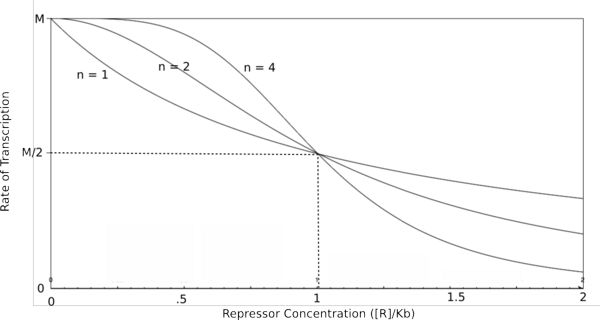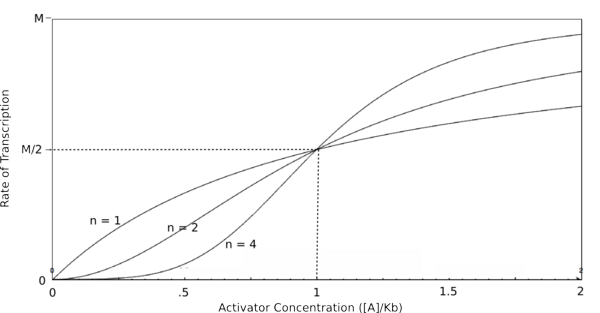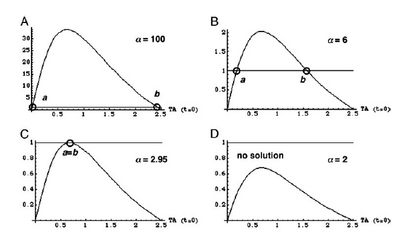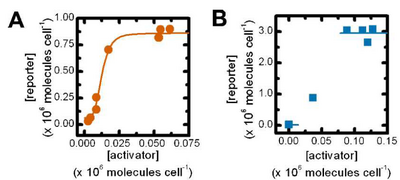Difference between revisions of "CellularMemory:Mathematical Models"
Wideloache (talk | contribs) |
Wideloache (talk | contribs) |
||
| Line 58: | Line 58: | ||
For both of the equations derived above, it can be reasoned that when high levels of repressor or activator are in their respective systems, the rate of change in transcription rate is relatively low. This is the result that we would expect, because at high levels of repressor or activator, the systems would become saturated and would be minimally affected by the addition of more repressor or activator. Unfortunately, the above equations do not accurately depict many systems when repressor or activator concentrations are low. This is because of the tendency of transcription factors to be composed of multiple subunits. While a single subunit (a monomer) can bind to its target molecule by itself, in order to achieve maximal binding affinity, it is often the case that multiple subunits (dimers, tetramers, etc.) are required. This phenomenon is referred to as the cooperativity of binding because it refers to multiple activator or repressor subunits working together to bind as tightly as possible. The equations above do not take cooperativity into account, however, the Hill equation modifies them so that cooperativity can be included in the description of binding. | For both of the equations derived above, it can be reasoned that when high levels of repressor or activator are in their respective systems, the rate of change in transcription rate is relatively low. This is the result that we would expect, because at high levels of repressor or activator, the systems would become saturated and would be minimally affected by the addition of more repressor or activator. Unfortunately, the above equations do not accurately depict many systems when repressor or activator concentrations are low. This is because of the tendency of transcription factors to be composed of multiple subunits. While a single subunit (a monomer) can bind to its target molecule by itself, in order to achieve maximal binding affinity, it is often the case that multiple subunits (dimers, tetramers, etc.) are required. This phenomenon is referred to as the cooperativity of binding because it refers to multiple activator or repressor subunits working together to bind as tightly as possible. The equations above do not take cooperativity into account, however, the Hill equation modifies them so that cooperativity can be included in the description of binding. | ||
| − | To do this, each equation above that yields the probability of the promoter being unbound by repressor (the third equation for each proof), is raised to the nth power, where n is the number of subunits involved in cooperative binding (the Hill coefficient | + | To do this, each equation above that yields the probability of the promoter being unbound by repressor (the third equation for each proof), is raised to the nth power, where n is the number of subunits involved in cooperative binding (the Hill coefficient). The equations are then multiplied by the maximal rate of transcription, M, yielding the Hill equations and graphs shown below. |
| − | |||
| − | |||
| − | |||
| − | |||
| + | [[Image:HillRepgraph.png|thumb|left|600px|'''Graph of the Hill equation for a repressor with Hill coefficients of 1, 2, and 4.''']][[Image:HillRep.png|thumb|right|150px|'''Equation 1: The Hill equation for a repressor.''' M is the maximal rate of transcription, [R] is the concentration of unbound repressor, K<sub>d</sub> is the dissociation constant and is equal to the repressor concentration that yields half the maximal transcription rate, and n is the Hill coefficient.]][[Image:linebreak.png]] | ||
| + | [[Image:HillActgraph.png|thumb|left|600px|'''Graph of the Hill equation for an activator with Hill coefficients of 1, 2, and 4.''' ]] | ||
| + | [[Image:HillAct.png|thumb|150px|right|'''Equation 2: The Hill equation for an activator.'''M is the maximal rate of transcription, [A] is the concentration of unbound activator, K<sub>d</sub> is the dissociation constant and is equal to the activator concentration that yields half the maximal transcription rate, and n is the Hill coefficient.]] | ||
[[Image:linebreak.png]] | [[Image:linebreak.png]] | ||
| + | In the graphs above, three things should be noted. First, when K<sub>b</sub> is equal to [R] or [A] (meaning that [R]/K<sub>b</sub> or [A]/K<sub>b</sub> equals 1), the rate of transcription is equal to half of the maximal value (M/2). Second, graphs of activators and repressors with a Hill coefficient of 1 are described by the Michaelis-Menten model (not taking cooperativity into account) Therefore, the Hill equation curves for n = 1 also represent the curves for the simple equations derived earlier in this section. Third, as n increases, the curves develop more and more sigmoidal (S-shaped) character, where the curve converges to two different values asymptotically. In the next section, this sigmoidal shape will be shown to be crucial in the establishment of bistability in a memory network. | ||
| − | |||
| − | |||
| − | |||
| − | |||
| − | |||
===The Monod-Wymann-Changeux Equation=== | ===The Monod-Wymann-Changeux Equation=== | ||
| − | [ | + | It should be noted briefly that, while the Hill equation accounts for cooperativity, it is not a completely accurate description of systems at very low concentrations of repressor/activator. The [http://en.wikipedia.org/wiki/MWC_model Monod-Wymann-Changeux] model improves on the Hill equation by taking into account a decrease in the dissociation constant as more repressor or activator subunits are bound onto a given complex. However, this model has not been shown to be necessary in modeling synthetic cellular memory networks. |
==Cooperativity and Bistability== | ==Cooperativity and Bistability== | ||
| − | |||
| − | |||
==Determining the Values of Funcational Parameters== | ==Determining the Values of Funcational Parameters== | ||
Revision as of 02:33, 30 November 2007
Main Page | Biological Designs | Mathematical Models | Toggle Switch | Hysteresis | Permanent Memory | Conclusions | References
|











